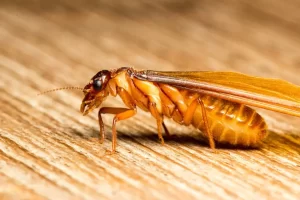Southern California Exterminators
Flying termites means serious trouble
Flying termites means serious trouble
Seeing winged termites in Orange County in general could be an ominous warning comparable to a black cat crossing one’s path- which is to say, it indicates potential misfortune. We can help w termite control in Corna CA and pest control services in Orange County, South/East Los Angeles County
When swarms of these flying termites appear in or near your home, it is a red flag signifying two possible perils:
1. An existing termite infestation might already be present.
2. Your home could be susceptible to a potential termite invasion.
However, the flying termites or swarmers themselves are not the ones causing damage. The real culprits are their offspring, who can wreak havoc on your property once they settle and begin a new colony.
Identifying Termite Swarmers in US: A Look at Dampwood, Drywood, and Subterranean Varieties
Termite swarmers, or alates, are brown-to-black adult reproductive termites from various species such as drywood, subterranean, and dampwood commonly found in the USA. Emerging in large groups from their colonies, these termites with straight antennae, four translucent wings, and a broad waist are in search of their next dwelling. Looking for reliable termite control?
Some ant species also swarm around the same time of year, so you might confuse the two. However, flying ants have bent antennae, a larger set of forewings compared to the rear wings, and a narrower waist. Treatment for termites and ants differs significantly, so proper identification is crucial.
Some experts say it is difficult to tell if you have termites. However, when termites with wings emerge from the nest to take flight, suddenly, you are presented with a very obvious, and not so subtle, sign of termites.
Another sign of a termite swarm is discarded wings. After swarmers take flight, they shed their wings, and if you have an infestation, you may find piles of wings around your property’s foundation.
HEADS UP: If you see winged termites indoors, you may have an existing problem. In other words, you may have termite-damaged timber or damaged furniture in your home.
A regular inspection of your home is key to preventing a termite infestation. Built-up moisture in the wood resulting from damaged timber on your property can attract termites. Below are a few things you can do now to protect your home and get rid of termites:
· Correct moisture issues such as leaks, drainage concerns, excess condensation, etc.
· Watch heating and cooling units closely for condensation issues
· Remove extraneous wood and debris from near your home and your yard, including construction materials, fallen trees, stumps, leaf litter, etc.
· Avoid wood-to-soil contact.
· Keep mulch pulled back from the foundation.
· Do not stack firewood next to your home – keep it at a distance.
· Do not use untreated wood or timber in construction projects such as decks, sheds, etc.
Termite inspections are essential for early detection of termite activity on your property. If you think you might have termites in your home, the sooner you call for help, the better. Ehrlich knows that no two homes are alike. Our termite experts will work with you to develop a customized plan that’s right for your home and family. Contact us today.
Get a free quote for your home.
Our new pricing tool can help you get a better estimated cost using a few factors like:
• Location
• Property size
• Pest type
What’s living inside your walls and ceiling? Protect your biggest investment from termites – your home How to save your home from termites
Does Homeowners Insurance Cover Termite Damage?
Insurance providers generally do not cover the expenses related to termite damage and removal under standard home, condo, or renters’ insurance policies. These companies view termite infestations as preventable, placing the responsibility and cost on the property owner. Thus, individuals should be prepared to bear the financial burden of addressing termite issues. Find out if homeowners insurance covers termite
damage in Orange County and what you can do to prevent and treat it. (800)-418-9263
Why homeowners’ insurance usually excludes coverage for termite damage in Orange County, CA
Does Homeowners Insurance Cover Termite Damage in Huntington Beach? Like homeowners’ insurance, renters insurance typically only covers sudden and direct losses caused by a covered peril. This means that termite damage is usually not covered by renters’ insurance. If you suspect that your rented property has termites, it is essential to promptly notify your landlord so they can arrange for a professional exterminator to address the issue.
- Maintain a two to three-foot distance between plants, mulch, and your home’s foundation. This prevents easy access for termites.
- Ensure that storm drains empty at least a few feet from your home’s foundation. This prevents moisture accumulation, which attracts termites.
- Repair any leaks in faucets, roofs, and gutters promptly. Damp areas are desirable to termites.
- When termites start swarming in the winter, turn off outdoor lights as these insects attract light sources.
- Schedule a professional pest inspection with a certified inspector, even if you believe your home is termite-free. Prevention is always better than dealing with an infestation.
- Avoid storing firewood close to your house. Termites are attracted to wood, and having firewood nearby creates an easy entry point.
- Choose treated wood for all construction projects, including your home, deck, and fences. Treated wood is less appealing to termites and helps prevent infestations.
Discover additional information regarding the coverage provided by homeowners insurance coverages.

